
What are Designer Drugs? | Worrying International Trend Emerges
Drugs that are legally produced and properly regulated can often be misused or abused. When a drug is produced illegally and not monitored for safety, it can cause serious issues, including severe mental and physical health issues as well as death from overdose. Designer drugs are synthetic drugs that are not legal and are extremely dangerous. Worse, a worrying international trend has emerged in the production and distribution of these designer drugs.
Avoiding Legal Safeguards
Designer drugs first became popular in the 1980s and 1990s as part of the “rave” and “club” scene that took off during those decades. The term “designer drugs” coincided with the rise in popularity of “designer” everything — from clothing to home decor to pharmaceuticals. But designer drugs were not named after designers. Instead, they were “designed” to avoid legal safeguards by producing similar effects to those drugs considered too dangerous to be legal.
Originally, the term was used to refer to drugs that were deliberately created to mimic older drugs of abuse, but with a slightly modified chemical structure, to circumvent drug laws. Designer drugs are untested, are often made in uncontrolled clandestine laboratories, and are extremely dangerous and unpredictable in their effects.
Dangerous and Emerging Trends
The use of synthetic drugs, or designer drugs, has re-emerged in recent years as a worldwide problem. These drugs are clandestinely and illegally produced with the intent of developing substances that differ slightly from controlled substances in their chemical structure while retaining their pharmacological effects.
Designer drugs share similar chemical structures of certain controlled substances, and mimic their effects, but have not been declared controlled substances themselves. Designer drugs continually circumvent laws created by governmental agencies and it has been a constant battle to keep up with new formulations that are constantly emerging. These drugs are infiltrating communities across the country. New synthetic opioids or designer benzodiazepines showed the highest consumption increase of all designer drugs in 2019.
Bath Salts
One example of a designer drug that has increased in popularity is referred to as bath salts, which are from the synthetic cathinone class of drugs. Synthetic cathinones are central nervous stimulants and are designed to mimic effects similar to those produced by cocaine, methamphetamine, and MDMA (ecstasy).
These substances are often marketed as “bath salts,” “research chemicals,” “plant food,” “glass cleaner,” and labeled “not for human consumption,” in order to circumvent application of the Controlled Substance Analogue Enforcement Act. Marketing in this manner attempts to hide the true reason for the products’ existence—the distribution of a psychoactive/stimulant substance for abuse.
Bath salts are increasingly popular internationally as well. In a sign that designer drugs are becoming more prevalent in Australia, bath salts have been detected in the nation’s wastewater in the largest study of its kind in the country. Amphetamines are among 15 new psychoactive substances (NPS) found in a study of Australia’s metropolitan and regional wastewaters over the past three years. These emerging family of drugs mimic the effects of ecstasy.
Fentanyl
Another dangerous designer drug that is showing worrying international trends is fentanyl. Fentanyl is a synthetic opioid that is 80-100 times stronger than morphine. It is smuggled into the United States across the southwest border as well as through international mail and express consignment shipping services, primarily in powder and counterfeit pill form, indicating clandestinely produced fentanyl as opposed to pharmaceutical fentanyl. Increases in fentanyl containing counterfeit pills and related fentanyl pill pressing operations in addition to other novel preparations demonstrate traffickers’ continued efforts to expand the fentanyl user base.
Poisonings and Overdoses
Many people have been poisoned or suffered an overdose because of their poor judgment in using illegally acquired drugs. When someone buys from a drug dealer, there is no guarantee as to what substances will be in the drug itself.
In recent years, there has been a resurgence of designer drugs sold over the Internet, particularly synthetic versions of Viagra, marijuana, and anabolic steroids. These synthetic versions of recognized drugs carry all the risks of the originals and more. And regardless of promises of “legal” highs, law enforcement agencies increasingly are cracking down on drugs marketed as recognized drugs, regardless of actual chemical content.
In addition, designer drugs create difficulties for treatment, particularly in the initial acute stages. Without knowing what is causing a person’s intoxication, it is difficult to correctly administer appropriate medication. Many designer drugs are also addictive.
Contact Recovery Without Walls for Help with Your Addiction
Recovery Without Walls is an evidence-informed medical practice, using the most current medical research, exceptional psychotherapy, and integrative healing methods to address your specific addiction needs. During the COVID-19 pandemic, we encourage you to email or call us for care and answers to your questions. Contact us today to get help overcoming your addiction.

